Your computer features top-rated components. This chapter provides details about your components, where they are located, and how they work.
Getting to know your computer
Right side
Figura : Identifying the right-side components
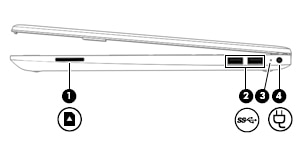
|
Component
|
Description
|
||
|
(1)
|

|
Memory card reader
|
Reads optional memory cards that enable you to store, manage, share, or access information.
To insert a card:
To remove a card:
|
|
(2)
|
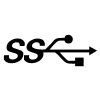
|
USB SuperSpeed ports (2)
|
Connect a USB device, such as a cell phone, camera, activity tracker, or smartwatch, and provide high-speed data transfer.
|
|
(3)
|
AC adapter and battery light
|
|
|
|
(4)
|

|
Power connector
|
Connects an AC adapter.
|
Left side
Figura : Identifying the left-side components
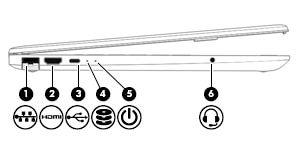
|
Component
|
Description
|
||
|
(1)
|

|
RJ-45 (network) jack/status lights
|
Connects a network cable.
|
|
(2)
|

|
HDMI port
|
Connects an optional video or audio device, such as a high-definition television, any compatible digital or audio component, or a high-speed High-Definition Multimedia Interface (HDMI) device.
|
|
(3)
|
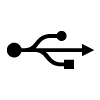
|
USB Type-C port
|
Connects a USB device, such as a cell phone, camera, activity tracker, or smartwatch, and provides data transfer.
Nota: |
|
(4)
|

|
Drive light
|
|
|
(5)
|

|
Power light
|
|
|
(6)
|

|
Audio-out (headphone)/Audio-in (microphone) combo jack
|
Connects optional powered stereo speakers, headphones, earbuds, a headset, or a television audio cable. Also connects an optional headset microphone. This jack does not support optional standalone microphones.
Avvertenza: Nota: |
Display
Figura : Identifying the display components
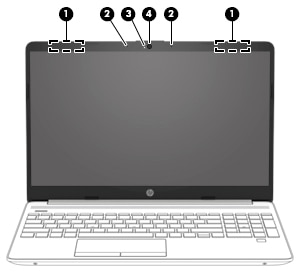
|
Component
|
Description
|
|
|
(1)
|
WLAN antennas* (1 or 2 depending on model)
|
Send and receive wireless signals to communicate with wireless local area networks (WLANs).
|
|
(2)
|
Internal microphones
|
Record sound.
|
|
(3)
|
Camera light
|
On: The camera is in use.
|
|
(4)
|
Camera
|
Allows you to video chat, record video, and record still images. Some cameras also allow a facial recognition logon to Windows, instead of a password logon.
Nota: |
|
*The antennas are not visible from the outside of the computer. For optimal transmission, keep the areas immediately around the antennas free from obstructions.
For wireless regulatory notices, see the section of the Regulatory, Safety, and Environmental Notices that applies to your country or region.
To access this guide:
|
Keyboard area
TouchPad
Figura : Identifying the TouchPad

|
Component
|
Description
|
||
|
(1)
|
TouchPad zone
|
Reads your finger gestures to move the pointer or activate items on the screen.
|
|
|
(2)
|
Left TouchPad button
|
Functions like the left button on an external mouse.
|
|
|
(3)
|
Right TouchPad button
|
Functions like the right button on an external mouse.
|
Lights
Figura : Identifying the lights
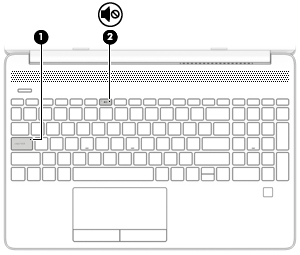
|
Component
|
Description
|
||
|
(1)
|
Caps lock light
|
On: Caps lock is on, which switches the key input to all capital letters.
|
|
|
(2)
|

|
Mute light
|
|
Button, speakers, vent, and fingerprint reader
Figura : Identifying button, speakers, vent, and fingerprint reader

|
Component
|
Description
|
||
|
(1)
|

|
Power button
|
Attenzione: If the computer has stopped responding and shutdown procedures are ineffective, press and hold the power button down for at least 5 seconds to turn off the computer.
To learn more about your power settings, see your power options:
|
|
(2)
|
Speakers
|
Produce sound.
|
|
|
(3)
|
Vent
|
Enables airflow to cool internal components.
Nota: |
|
|
(4)
|
Fingerprint reader (select products only)
|
Allows a fingerprint logon to Windows, instead of a password logon.
Nota: |
Special keys
Figura : Identifying special keys

|
Component
|
Description
|
||
|
(1)
|
esc key
|
Displays system information when pressed in combination with the fn key.
|
|
|
(2)
|
fn key
|
Executes specific functions when pressed in combination with another key.
|
|
|
(3)
|

|
Windows key
|
Opens the Start menu.
Nota: |
|
(4)
|
Action keys
|
Execute frequently used system functions.
Nota: |
|
|
(5)
|
num lock key
|
Alternates between the navigational and numeric functions on the integrated numeric keypad.
|
|
|
(6)
|
Integrated numeric keypad
|
A separate keypad to the right of the alphabet keyboard. When num lock is pressed, the keypad can be used like an external numeric keypad.
Nota: |
Action keys
An action key performs the function indicated by the icon on the key. To determine which keys are on your product, see Special keys.
-
To use an action key, press and hold the key.
|
Icon
|
Description
|
|

|
Helps prevent side-angle viewing from onlookers. If needed, decrease or increase brightness for well-lit or darker environments. Press the key again to turn off the privacy screen.

|
|

|
Decreases the screen brightness incrementally as long as you hold down the key.
|
|

|
Increases the screen brightness incrementally as long as you hold down the key.
|
|

|
Opens the “How to get help in Windows 10” webpage.
|
|

|
Switches the screen image between display devices connected to the system. For example, if a monitor is connected to the computer, repeatedly pressing this key alternates the screen image from the computer display to the monitor display to a simultaneous display on both the computer and the monitor.
|
|

|
Turns the keyboard backlight off or on. On select products, you can adjust the brightness of the keyboard backlight. Press the key repeatedly to adjust the brightness from high (when you first start up the computer), to low, to off. After you adjust the keyboard backlight setting, the backlight will revert to your previous setting each time you turn on the computer. The keyboard backlight will turn off after 30 seconds of inactivity. To turn the keyboard backlight back on, press any key or tap the TouchPad (select products only). To conserve battery power, turn off this feature.
|
|

|
Plays the previous track of an audio CD or the previous section of a DVD or a Blu-ray Disc (BD).
|
|

|
Starts, pauses, or resumes playback of an audio CD, a DVD, or a BD.
|
|

|
Plays the next track of an audio CD or the next section of a DVD or a BD.
|
|

|
Stops audio or video playback of a CD, a DVD, or a BD.
|
|

|
Decreases speaker volume incrementally while you hold down the key.
|
|

|
Increases speaker volume incrementally while you hold down the key.
|
|

|
Mutes or restores speaker sound.
|
|

|
Turns the airplane mode and wireless feature on or off.
Nota: Nota: |
|
Bottom
Figura : Identifying bottom components
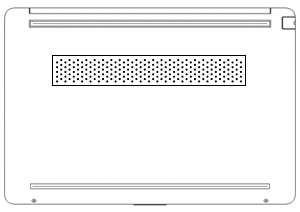
|
Component
|
Description
|
|
Vent
|
Enables airflow to cool internal components.
Nota: |
Labels
The labels affixed to the computer provide information you may need when you troubleshoot system problems or travel internationally with the computer. Labels may be in paper form or imprinted on the product.
Nota:Check the following locations for the labels described in this section: the bottom of the computer, inside the battery bay, under the service door, on the back of the display, or on the bottom of a tablet kickstand.
-
Service label—Provides important information to identify your computer. When contacting support, you may be asked for the serial number, the product number, or the model number. Locate this information before you contact support.Figura : identifying the service label
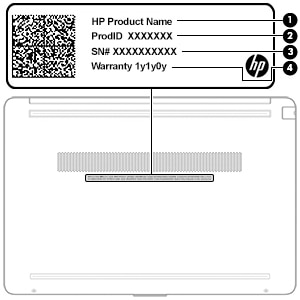
Service label components Component(1)Product name(2)Product ID(3)Serial number(4)Warranty period -
Regulatory label(s)—Provide(s) regulatory information about the computer.
-
Wireless certification label(s)—Provide(s) information about optional wireless devices and the approval markings for the countries or regions in which the devices have been approved for use.
Inserire un argomento per cercare nella nostra libreria di conoscenze
Come possiamo aiutarti?
Serve aiuto?
 , and then select
, and then select 